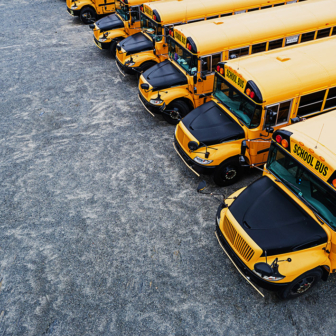1. Has Australia been spending more and more on schools?
Yes, and no. Over the past decade or two, as a proportion of GDP or relative to other countries, not really. Compared to other education sectors (vocational education and training and, by some measures, higher education), yes. As an amount spent per-student per-year, over the long term, yes. The best available estimate is that between 1963–64 and 2003–04 spending (in 2003–04 dollars) rose from $4575 per student to $8297. Recent increases, alleged to have been spectacular, almost certainly weren’t. These overall figures conceal substantial differences in spending between states, sectors and schools.
2. So, Australian schools are well funded?
Yes, and no. Australian spending is at about the OECD average, but that’s the total spend, not the particular. Some secondary schools (for example) have around $30,000 to spend on each student each year; most others have around half that. Big spending sometimes reflects need (schools in some remote Aboriginal communities, for example), but mostly doesn’t.
To the contrary. Thanks to the workings of the real estate market and of choice (by families) and selection/exclusion (by schools), most high-revenue schools cater to high-income clienteles. That also gets them more than their fair share of that most valuable of all educational resources, students who are good at schoolwork. Other schools with much less money thereby get to do a harder educational job.
On top of this systemic inequality is simple unfairness. A primary school on one side of the NSW–Victoria border (for example) gets $9672 per student per year, while a very similar school on the other side gets $7732. The money problem is not in the amount spent, but in how it is distributed, and used.
3. Is the money used as well as it could be?
Not really. Over the long term, more money has helped to make schools more congenial and humane places than they once were, which is no small thing. But much spending has been driven by politics rather than purpose. For two or three decades from the 1960s, most extra funding went on the high-cost, low-effectiveness strategy of across-the-board reduction in class sizes. Since then, funding increases have been soaked up by rising costs (salaries mainly), as the Baumol Effect predicts. Any genuinely “new” money (over and above cost increases) has typically gone to meet special needs (of children with disabilities particularly) and to repair damage done in the mainstream (low student engagement in secondary schools, for example), rather than to change the mainstream.
Only rarely has new money been used to free up the “old” money locked up in the “grammar of schooling” (one teacher, one class, one lesson of forty-five minutes in one subject, and so on). That “grammar,” in turn, is locked into place by industrial agreements that set limits on the size of every class (rather than maximum student–staff ratios), enforce a strict division of labour between teachers and “support staff,” and prohibit “person–technology swaps.”
In short, each school should be doing its own Gonski, matching effort to need, but can’t. And, in sum, we have a cumulative incrementalism in which problems and costs increase faster than solutions can be provided.
4. So schools have more money but haven’t lifted their game?
No, and yes. The obvious but simple-minded conclusion, favoured by some economists, federal ministers of education, and pundits, is that spending more doesn’t work. The argument is that PISA, NAPLAN and other standardised tests show that attainment has plateaued while funding hasn’t. Leaving to one side the vexed question of how well standardised tests measure some aspects of some areas of the academic curriculum, and the fact that the academic curriculum is not the whole school story by any means, it remains true (as per point 3, above) that money has been spent where it is not needed and not where it is, and on more of the same rather than repurposed.
But these are failures of the system, not of schools. So is the tidal movement of families who can choose away from those who can’t, making it more and more difficult for many schools to lift attainment. On top of which, schools are endlessly expected to do more things (sex ed, life skills, twenty-first-century skills, careers ed…) and harder things (handle kids who for a range of reasons aren’t easy to handle and/or come from an ever-expanding range of language and cultural backgrounds). Perhaps not going backwards is an achievement? Perhaps the test scores would have been worse if spending hadn’t increased?
5. Why the endless brawling over money?
It’s the structure, stupid: three sectors, each funded in different ways from three different sources; two levels of government involved, one with the responsibility, the other with the money; some schools charging fees, others free (well, nominally anyway); some schools (including some government schools) selecting or ejecting students on academic and/or financial and/or religious grounds, others required by law to take all comers. These arrangements are international worst practice, a recipe for gaming the system and for conflict.
Everyone has been given a legitimate basis for grievance. The fee-payers argue that they need more government support to keep fees down and because they are taxpayers after all. The non-fee-payers point out that their schools are open to all and do the hard educational yards, and therefore deserve first claim on the public purse. The selective public schools (government-funded private schools, really) keep their heads down. The system creates a large space, and rewards, for politics, and minimises the role of evidence and expertise. Interest groups form around different categories of school, and ideologies form around them. Brawls over the second-order question of funding displace debate over the first-order question of the character and direction of schooling as a whole.
6. Where did these problems come from?
The Whitlam government, in the first instance. It was Whitlam’s famous Karmel Report of 1973 that determined that some schools would be funded and others merely “aided”; that therefore some parents who couldn’t afford it would pay and that many who could, wouldn’t; that parents would therefore have the right but not necessarily the capacity to choose; that some schools would select but others wouldn’t; that there would be, in short, three sectors funded in different ways, governed in different ways, with very different rights and obligations.
Of course, Whitlam (and Karmel) didn’t just dream it up. They made the best politics they could from the furious “state aid” debates of the 1950s and 1960s, which stemmed from the movements in the second half of the nineteenth century to end the decades-old system of public support for private schools, which stemmed from fundamental demographic and political facts the Europeans brought with them… Whitlam’s biographer called it Australia’s “oldest, deepest, most poisonous debate” – and that was 1977.
7. Did Gonski have the fix?
Yes, and no. Gonski’s proposals included: a fair and rational way of deciding what funding each school needed, irrespective of sector, location or clientele; a national authority to run the detail, and thereby shift the balance of funding decisions away from politics and towards evidence and expertise; a way of making the states “maintain effort” rather than use federal money to substitute for their own; and a way of putting money behind an educational strategy centred on need.
Not bad. But it is a measure of the depth of the trouble we’re in that this left five substantial problems still to be tackled: some parents paying fees and others not, irrespective of capacity to pay; some schools (and families) still able to outspend others by as much as they like; some schools able to select or exclude on grounds of income, academic ability or religion; two levels of government with coordinated funding but no clear division of labour and responsibility in other areas; and no encouragement to use new money to free up old, for each school to do its own Gonski. Even this less-than-complete program required five or six billion dollars a year in new money to lubricate the wheels of change – a tacit acknowledgement of the power of sectoral lobby groups. Gonski’s limitations, it should be emphasised, came not from the panel but from its riding instructions.
8. Was Gonski trashed by Bill Shorten, as alleged by federal education minister Simon Birmingham?
Hardly. Shorten played a late and minor role in doing on-the-fly deals with states and territories. These were mere nails in the coffin. It was Peter Garrett, Shorten’s predecessor in the education portfolio, who did most of that part of the damage, and he did so at the behest of his prime minister, Julia Gillard. Gillard deserves much of the blame for not driving Gonski home when she had the chance, thus giving the usual interest groups time and opportunity to bowdlerise a singularly bold and coherent plan. On the other hand, Gillard also deserves much of the credit for getting Gonski under way, as education minister and then as prime minister.
As for Mr Birmingham’s Coalition predecessors, what can we say? They were duplicitous spoilers from the outset: first bad-mouthing the whole idea; then egging on Coalition-governed states to reject it; then promising (at the eleventh electoral hour) a “unity ticket” on Gonski; then (nano-seconds after the election) junking it; and now, having found themselves wrong-footed by Gonski’s wide and deep support (not least inside the conservatives’ own ranks), having the gall to claim that it was Labor all along that has been the villain of the piece.
9. Will the Birmingham plan do the needful?
It’s too soon to tell if there is a plan or, if there is, whether it is any good, but early signs are less than promising. On Friday last week the minister took his proposals to a meeting with his highly sceptical state counterparts. It is difficult to be optimistic about the likely outcome. On the positive side, Birmingham made constant references to “need” and “needs-based funding,” a victory for Gonski. He also made the entirely accurate observation that Gonski has been trashed. And he hinted at a willingness to redistribute money away from those who don’t need it and towards those who do. But the usual suspects have already fired warning shots, and the minister has squibbed on fixing the big differences in spending between states. He refers to Gonski as a “funding formula,” which forgets essential elements, including a comprehensive agreement between states and sectors and the machinery needed to make it work (a national schools resources body, and state-level coordination of planning for new schools). There is little or no new money to secure state and sector buy-in.
10. Is there a way out?
In the short term, perhaps. In the longer run? Learn from the AFL. Use funding and regulation to make sure that no “team” gets too far ahead or too far behind, that all are equipped, encouraged and required to provide an educationally engaging program to a diverse clientele. That wouldn’t involve abolishing existing authorities (government, Catholic, and so on), practices (including choice) or rights (including to religion-based schooling), but it would mean constructing an overall framework within which all could operate more fairly, efficiently and productively. The prerequisite to success in reforming practice (“teaching quality” and the like) and lifting performance is fixing the unfair, inequitable, politics-sodden, inflexible and counterproductive combination of funding and regulation within which schools work.
The key is to level up the playing field. That would mean putting all families on the same basis, either none paying fees (not necessarily as big a hit to the public purse as might be thought) or, much less desirably, all required to pay (or be eligible for subsidy) according to taxation status. It would mean putting a ceiling on funding as well as a floor under it, and making school choice more widely and fairly available, in all three sectors. That is, of course, a bold program, minister. It raises a host of technically and politically difficult questions. It would demand leadership of the kind showed by John Dawkins in higher education in the 1980s, Paul Keating on land rights in the 1990s, or John Howard on gun control not long after. Too hard? Probably. In which case Australia’s “oldest, deepest, most poisonous debate” and the schooling system that comes with it can look forward to a few decades yet. •




